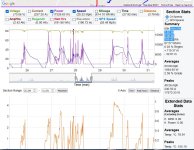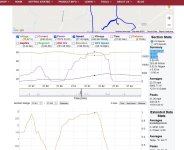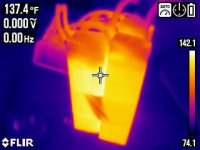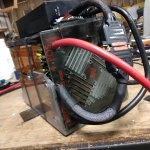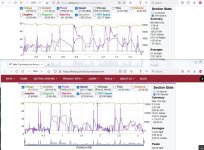I just pulled 23.8 horsepower out of some Chevy 25Ah cells. They did not blink. The motor was blazin and the controller was a lil hot. 17,800w plus. 90 lb bike give or take.
The pack was built with a fan in mind. 12v, 120mm, PWM outputs on a Nuclear in mind. I do not think I need it. The pack did not get one degree hotter. On any of the sensors on the system, and with the thermal data. This shows a 9.72C peak. CA3.14 shows 28-40mOh for the pack IR. Data I have read states that the cells will not show any increase over RT until continuous current draw of 4C... 100A. From the limited data I got.
QS205. I did take pictures of it. I'll update when I can. The pack gets hotter on charge, than at this level of discharge. Hmmmm.
For reference, here is a pic of a RC lipo.. so called "65C " contin.. and only managed to push about 30C peak. This bike only pulled 163A on the 72v, 5Ah, 2mOh/cell lipo. Hot Potato Lipos are..... hot. Direct product of an undersized pack, faltering.
It is a little bit of a surprising volume for a Chevy cell NMC-LMO pack. It still gives good range and incredible power for its small capacity ( 1.85kWh) on this bike ( that can fit 3-4kWh of 18650 in it).
Point is.. I dont think we need cooling so much anymore... the cells are getting better and better.
Ianhill said:
Id thinking of using 21 lg 60ah li nmc cells that can deliever 240amp a cell but heating occurs nothing drastic but 20 mins of that build up would lead to a hot pack.
If the cells do not get hot, they do not get hot. Kinda what I am learning.
Can confirm they will zap 240A pretty easy. This log is made on a Kelly of 8kW rating. 72v system. KEB72801X. 240A peak up a hill @ 50mph.
flippy said:
also, adding more capacity and cells in this manner will give you a considerable less amount of voltage sag, heat production and capacity.
Yes kinda what I learned. I wonder about the threshold.. where is to small, and what is too hot.. I guess it is kinda self explanatory.. Either your cells can hack it.. or they cannot. Temperature yields the data of the application ( sized capacity)...
Still..... How do you ABSOLUTELY know if the cells will hack it or not? That is in the questions?
As for ones implementation and design skill, use of tooling and time, I will not say anything, for I have a disagreement there, Flippy. Regarding the merits of a 600 cell spot welded pack vs a 21 cell larger format pouch cell design, housing and whatnot included. Personally. Personally I have seen many spot welded packs fail for poor mechanical designs. Time is the essence of control and the amateur builder is not skimping on time where the investment of 600 cells is involved or else risk expense.
Some of us are faster than others. Some may build faster, some may build slower. Truth be told, not a level playing field. Not a good comparison. But Yeah.


